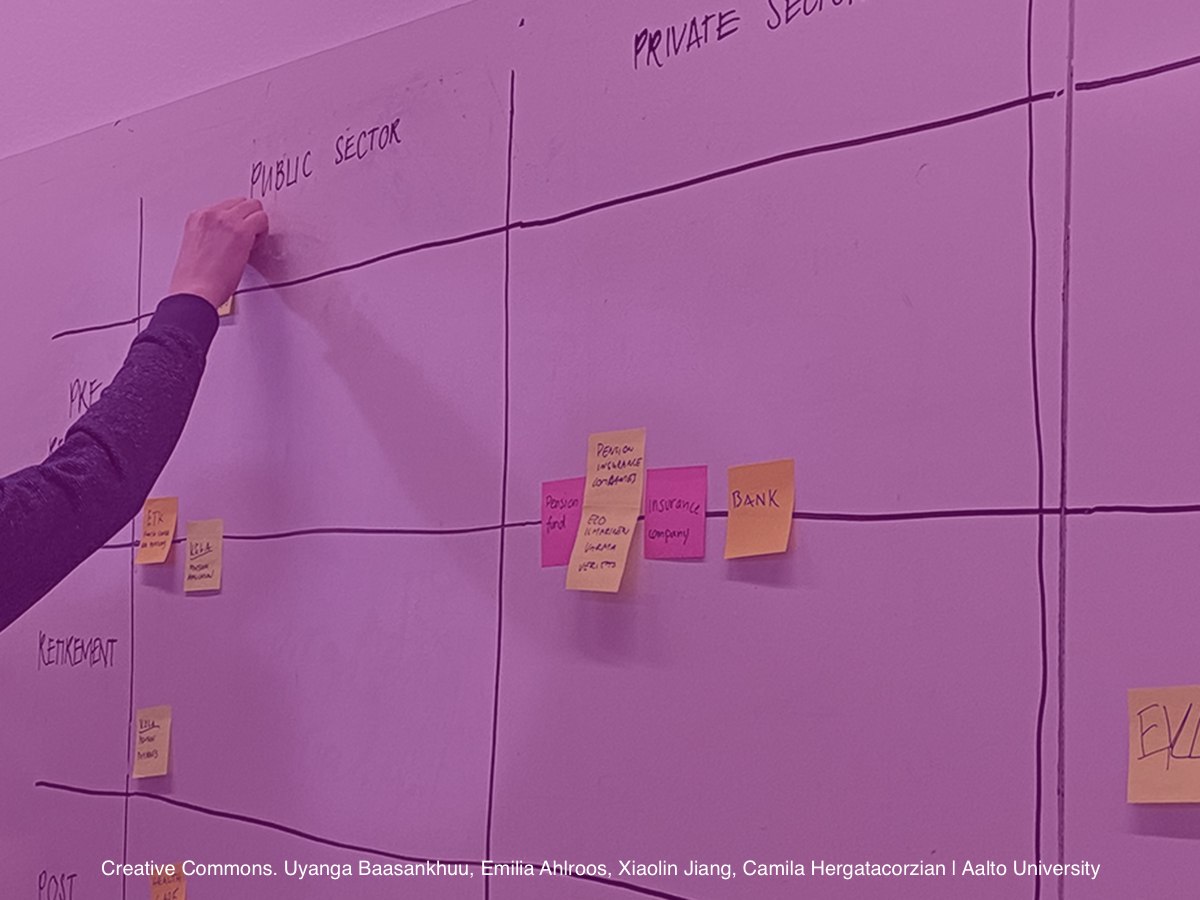This blog post reports on work-in-progress within the DfG course! The post is written by group 1B working in collaboration with the Digital Population and Data Services (DVV) and the Ministry of Finance (VM) on the project ‘Life events for a dignified old age’. The group includes Uyanga Baasankhuu from Collaborative and Industrial Design program, Xiaolin Jiang from Human Computer Interaction program, Regina Gensinger from Creative Sustainability program, and Camila Hergatacorzian from Collaborative and Industrial Design program.
Written by: Camila Hergatacorzian
We started our journey on the Design for Government course three weeks ago, and by doing this recap, I suddenly realized how many things have been going on. Of course, everything has been super relevant, but there is one thing stuck in my head: How does intertwining design and policy look like? As we have the time to reflect on what we do every week, I will use my notes on this issue to extend the discussion on this post, and hopefully even help myself to understand it a bit better.
Reflecting on what we do (or might be doing) when we design for government
Our first contact with the course was through Jocelyn Bailey’s lecture, which was very clear in many ways, but it also raised many doubts. Bailey’s lecture started framing what we would be doing in the following months with a lovely chart on “How does design intersects with the government”. What I liked about the chart was that it featured familiar design categories. Seeing design areas such as industrial or graphic design being displayed gave me the feeling that the challenge we were about to take on was closer to what I knew. On the other hand, what raised more questions was the definition(s) of policy. But maybe it’s a matter of getting used to being confused with the term from now onwards. Trying to make sense of the concept, we were also introduced to a series of steps/cycles of how policy performs. Each stage was also linked to one of the Danish Design Ladder steps. So, this could be where both processes finally meet!
Unpacking the brief: placing it in-between policy stages
After reading the “Life events for a dignified old age” brief we were assigned to, based on our interpretation, start placing it in between the formulation and implementation steps of the policy cycle. What seemed like another clear diagram was now raising even more questions after being confronted with a real case. For my group and I, the brief seemed to be closer to formulation than it was to implementation (see fig 1). Now, let’s problematize this idea so I can understand better why we thought of placing it there.

Figure 1. Placing the design brief in the policy cycle.
One could also say that the brief was about moving from policy formulation to implementation along the course. In this sense (and going back to the Design Ladder), the first period would be oriented to conducting research and re-framing the brief by having “design as a process”. And the second one would be about problematizing the possibilities for design interventions, thus thinking more in terms of “hows” and “giving form” (see fig 2).

Figure 2. Placing the design brief along the course.
In traditional design projects, one would be used to iterate between researching, giving form and evaluating many times and within relatively short periods of time. This process could be repeated so many times that we no longer dare say, “this IS the FINAL design!”. However, in this case, the difference might be that we could have a whole design process in the public sector that gives no form at all. Or maybe, it gives such an abstract form that we can’t recognize a traditional design outcome on it. As Julier points out in his book Design Economies (2017), the new materiality of design, consisting of “…transparency and inclusivity (…) suggest a shift from design as a noun (an output of process) to design as a verbal noun (the process itself).”. This point actually makes a lot of sense with the brief!
One of the points in which this notion makes sense is in the brief “expected outcomes”. There, one could read how two of the three possible outcomes of this partnership were “use cases” and “policy recommendations”. So, do designers have something to offer that is not “a thing”? Or how can these new abstract outcomes also become design “things”? Hopefully, my colleagues’ future posts will help in finding answers to these questions.
Building human-scale policy
Last, all our concerns about policy and design can remain in our heads, but we will not stop there! We can leave these questions aside for a while and focus on what we know best: complex human-centred + systems research and analysis, a.k.a: design research. This far, it looks like the construct of what “old age” traditionally means is being challenged by our DVV partners and the research participants. How is old age going to be like in the future? We are currently exploring the answers to this, but I won’t spoil more… the best is yet to come!
References:
Julier, G. (2017). Economies of design. SAGE Publications Ltd, https://doi.org/10.4135/9781529714418
08.03.2021 DfG Open Lecture: Design for Policy By Jocelyn Bailey, n.d.
The DfG course runs for 14 weeks each spring – the 2023 course has now started and runs from 27 Feb to 31 May. It’s an advanced studio course in which students work in multidisciplinary teams to address project briefs commissioned by governmental ministries in Finland. The course proceeds through the spring as a series of teaching modules in which various research and design methods are applied to address the project briefs. Blog posts are written by student groups, in which they share news, experiences and insights from within the course activities and their project development. More information here about the DfG 2023 project briefs.

